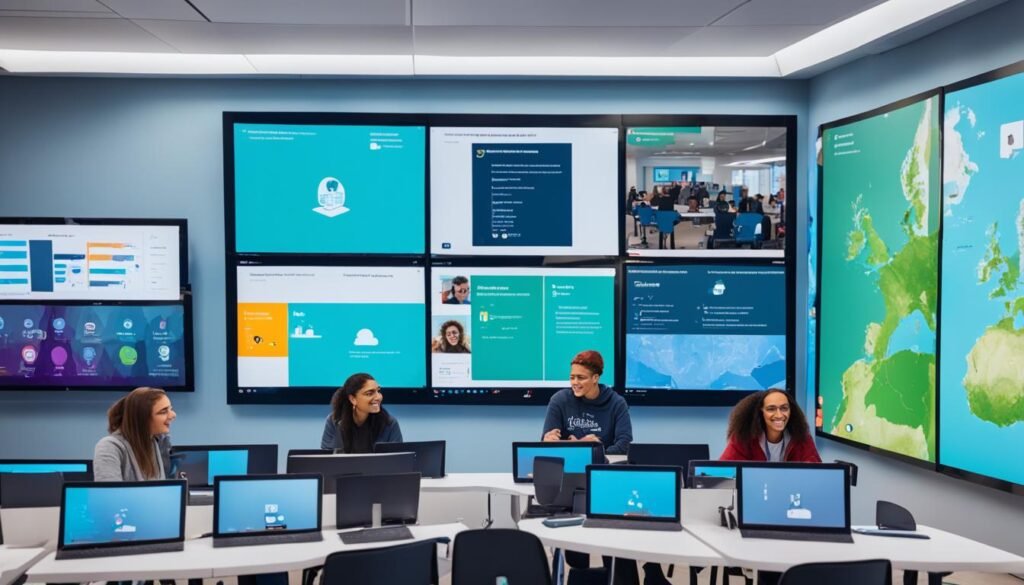Envision an era without the constraints of traditional classrooms, where learning transcends physical boundaries to offer an expansive and interactive experience. Welcome to the frontier of education, the domain of virtual classrooms. These versatile and dynamic online platforms are reshaping our educational paradigms, ensuring unmatched ease of access, adaptability, and user engagement. The question remains – are virtual classrooms destined to redefine the educational landscape as we know it, or are they ephemeral phenomena? To ascertain the transformative potential of these online learning platforms and e-learning environments, an in-depth exploration is imperative.
Key Takeaways
- Virtual classrooms leverage digital education tools and remote teaching technologies to create virtual instructional spaces for interactive online learning.
- Interactive online classrooms empower students and teachers to collaborate remotely, using web-based learning management systems and cloud-based educational solutions.
- Advancing technology heralds a future where virtual classrooms will offer unprecedented opportunities for both teaching and learning, facilitating an environment that is more accessible, fair, and sustainable future for education.
- Multimedia virtual classrooms facilitate an engaging and immersive learning platform, transcending geographical limitations and ensuring educational access for all.
- The evolution of virtual classrooms hinges on the amalgamation of cutting-edge technologies like artificial intelligence and virtual reality, promising even further enhancement of the educational and personalization experiences.
Defining Virtual Classrooms
Virtual classrooms represent a paradigm shift in education, amalgamating digital interfaces with remote teaching apparatus. By employing interactive platforms, they not only transcend geographical barriers but also enrich the educational experience by fostering collaborative and immersive learning experiences. This departure from the traditional classroom setting signifies a progression towards a pedagogical sphere unbounded by physical constraints.
Digital Learning Environments
The nucleus of virtual classrooms consists of web-based learning management systems intertwined with cloud-based educational solutions. These amalgamate to form digital realms in which synchronous and asynchronous learning processes converge. As a result, the location is no longer a barrier; students and educators alike can convene virtually, partaking in everything from lectures to joint projects, fundamentally redefining educational paradigms.
Interactive Online Platforms
Virtual classrooms are underpinned by platforms that invigorate learning. They introduce elements like live video lectures and real-time chat, hence creating a conduit for dynamic student involvement. These features not only facilitate intellectual discourse but also breed a community ethos among learners and instructors. Thus, the didactic process thrives, bolstered by an ethos of engagement and collective learning, within a digital domain.
Remote Teaching Technologies
The essential backbone of these classrooms is a suite of remote teaching tools that envelop instruction and learning. Ranging from video conferencing to interactive whiteboards and file-sharing functionalities, these provisions undergird the educational process, ensuring the persistence of a personalized educational venture. This framework empowers lecturers to nurture student learning actively and in real-time, mirroring the dynamics of traditional classrooms, albeit within a digital milieu.
Accessibility and Inclusivity
Virtual classrooms transcend the boundaries of traditional education, offering unparalleled inclusive learning environments. They provide opportunities for learning unbound by geographical location. This is especially vital for individuals hailing from various locales, ensuring equitable access to quality education through the vast expanse of the internet.
Overcoming Geographical Barriers
The accessibility of virtual classrooms ensures that geographic impediments do not hinder educational opportunities. By existing outside the realm of physical classrooms, they level the educational playing field, permitting individuals from anywhere to partake in transformative learning. This digital domain thus underscoring the power to transcend geographical barriers that once limited educational prospects.
Inclusive Education for All
The shift towards inclusivity in virtual classrooms represents a profound leap in educational access. It extends a lifeline to those historically pushed to the margins of education, inviting them into a space where they can fully engage in learning. This paradigm shift heralds a more inclusive education model, promising boundless opportunities for learners irrespective of background or ability.
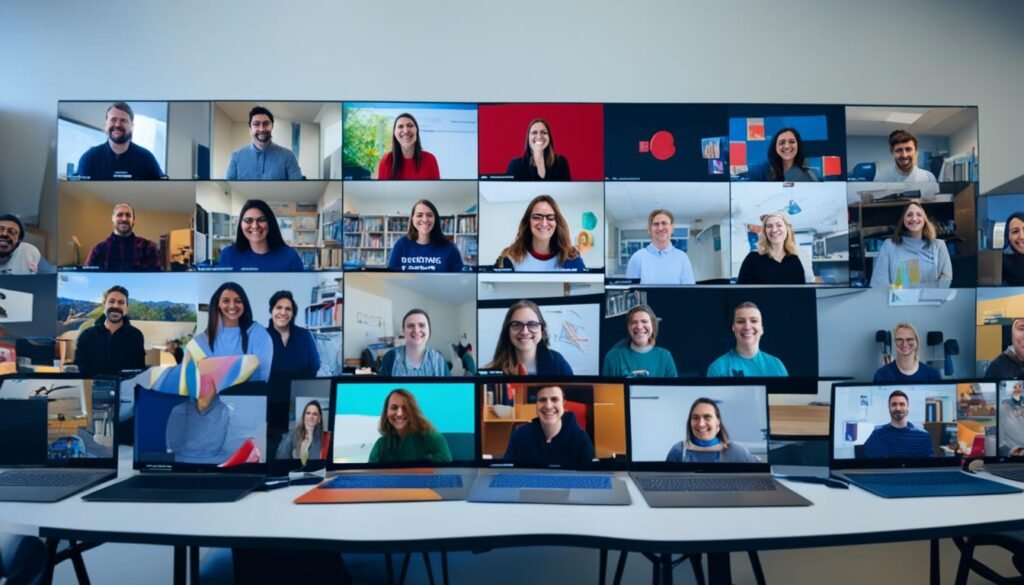
Flexibility and Convenience
Virtual classrooms epitomize flexibility, allowing students freedom to join courses from various locales. Be it the sanctuary of their dwellings, a quaint café, or amidst travels. This availability is a godsend for non-traditional scholars – those entrenched in professions or parenthood. Individuals navigating demanding routines find solace in not being tethered to fixed class sessions.
Anytime, Anywhere Learning
The paradigm of anytime, anywhere learning epitomized by virtual classrooms is transformative. It emancipates students to imbibe educational content and partake in learning modules at their sovereignty, unhindered by temporal constraints. This might entail revisiting a archived lecture midday or engaging in a real-time discourse from a distant locale. Virtual platforms synergize with the kaleidoscopic routines of contemporaneous students, allowing education to be seamlessly woven into their diverse fabric.
Accommodating Diverse Learners
Virtual classrooms bear a mantle of inclusivity, aiming to accommodate the diverse needs of learners. They proffer a spectrum of personalization, entailing customization of aspects like typography, visual themes, and auditory settings. Such tailoring crafts an optimal learning milieu, engendering a space where every student can orchestra their unique learning proclivities.
Interactive and Engaging Experience
The prevailing notion that online education is void of personal touch is grossly inaccurate. In fact, virtual classrooms provide an interactive and engaging experience par excellence. Possessing the capacity for live video lectures, real-time chats, and collaborative tools, these educational platforms enable students to actively engage in discourse, pose queries, and collaborate with both peers and educators alike.
Live Video Lectures
The ethos of immediacy and connectivity is paramount in live video lectures. In this arena, students are afforded the opportunity to engage directly with instructors and peers, in a live, synchronous fashion. This format not only stimulates active participation but also cultivates a learning atmosphere that is both immersive and enthralling.
Collaborative Tools
The arsenal of collaborative tools within virtual classrooms simplifies the process of teamwork and group undertakings. Exhibiting amenities such as interactive whiteboards, breakout rooms, and shared document editing, these platforms enable the seamless cooperation of students. Thus, they can jointly navigate projects, exchange ideas, and proffer constructive insights to their peers.
Multimedia Presentations
In the quest to augment the engaging experience, virtual classrooms incorporate an array of multimedia presentations. The spectrum ranges from interactive simulations and compelling videos to instructive slideshows. Beyond their aesthetics, these multimedia components serve the dual purpose of enhancing visual appeal and bolstering the comprehension of fundamental themes.
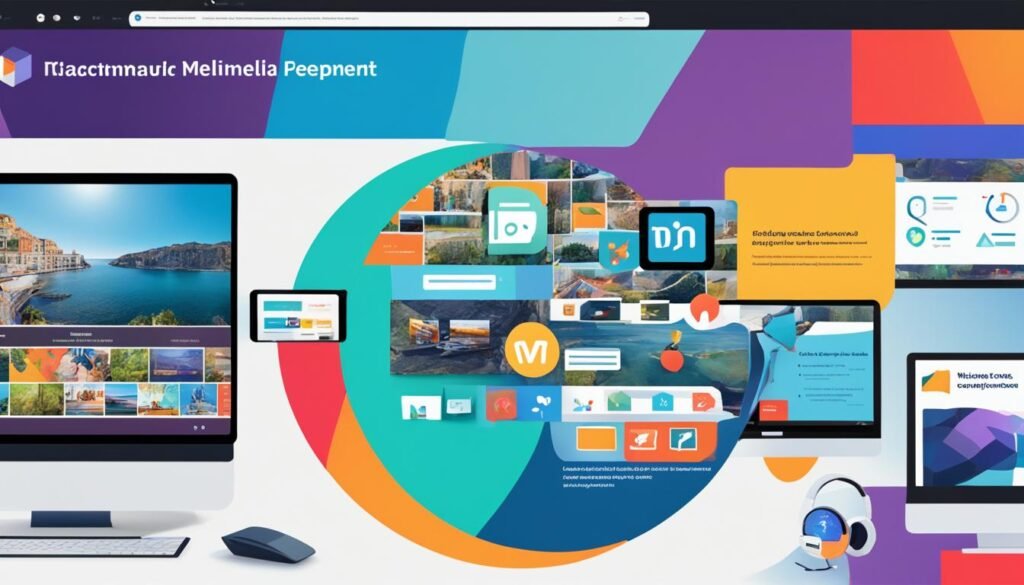
Personalized Learning Pathways
Virtual classrooms are at the forefront of customization, empowering students to adjust their learning settings according to their personal preferences. This includes modifying aspects like font size, background color, and audio configuration. Such personalization creates an environment that fosters concentration and active engagement.
Tailored to Individual Needs
In the realm of virtual education, instructors can finely tune content and activities to address a broad array of learning styles. This is achieved by meticulously examining student performance data, grasping their preferences on a granular level, and recognizing their innate strengths. In utilizing this information, educators forge personalized learning pathways customized to meet the distinctive needs of each participant. Thus, every student is positioned for success, enabled to reach their educational aspirations.
Customizable Learning Environment
The adaptability of virtual learning spaces allows students to fashion a customizable learning environment that is tailored to their specific requirements. From adjusting font sizes to choosing calming background hues that alleviate visual fatigue, to honing in on optimal audio configurations for an enriched immersive experience, control over personalizing one’s learning journey is firmly in the hands of the learner. This control significantly enriches the student’s educational experience.
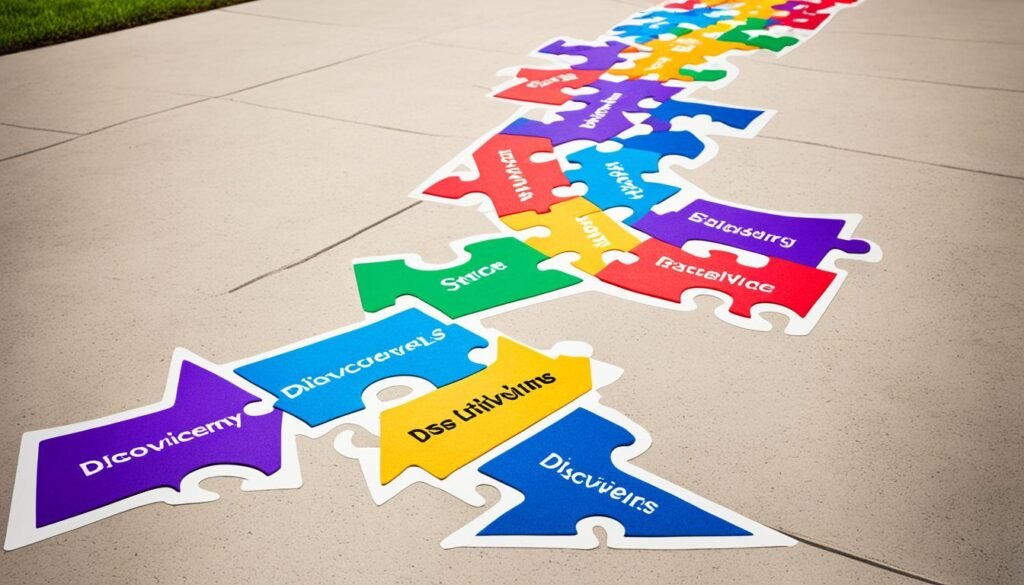
virtual classrooms
Virtual classrooms are underpinned by sophisticated, web-based learning management systems and cloud-centric educational solutions. These innovative frameworks maximize the quality of digital learning experiences. By amalgamating a rich array of tools, they empower both scholars and educators. This fusion facilitates dynamic collaborations, delivers a plethora of educational resources, and liberates teaching and learning from the constraints of physical locations.
Web-Based Learning Management Systems
At the core of virtual classrooms are web-based learning management systems, which function as the nerve center for digital learning activities. They amalgamate a spectrum of features including course design, content distribution, measurement mechanisms, and avenues for interaction. This convergence simplifies the educational journey for all involved, disseminating knowledge effectively. The nature of web-based LMS ensures that these educational enrichments are globally accessible, thereby eliminating the geographical boundaries of conventional learning.
Cloud-Based Educational Solutions
Adding a layer of versatility and scalability to the virtual classroom model is the deployment of cloud-based educational solutions. These infrastructures offer agile and elastic support for digital learning, facilitating the collaborative and individual engagement of students and educators. Operators within this paradigm can partake in both synchronous and asynchronous activities, engage with dynamic multimedia resources, and access these through a variety of internet-connected gadgets. The essence of these cloud solutions maintains a secure, current, and universally reachable educational landscape, which is instrumental in crafting a vibrant and interactive online educational journey.
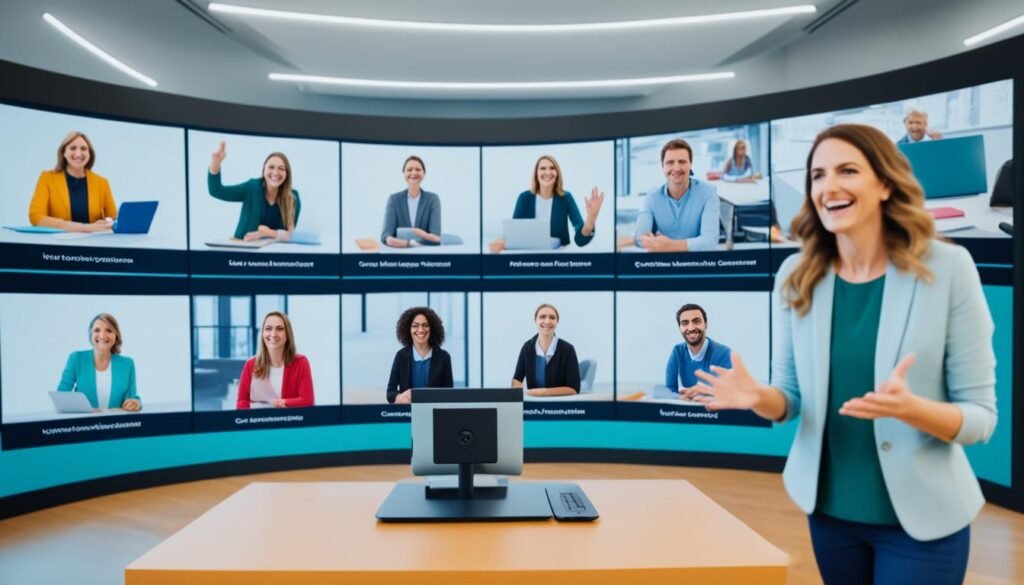
| Feature | Web-Based Learning Management Systems | Cloud-Based Educational Solutions |
|---|---|---|
| Accessibility | Accessible from any location with an internet connection, promoting global reach and inclusivity. | Accessible from any device with an internet connection, enabling anytime, anywhere learning. |
| Collaboration | Offers features for real-time collaboration, such as video conferencing, shared whiteboards, and project management tools. | Facilitates seamless collaboration through cloud-based file sharing, co-authoring, and communication tools. |
| Content Management | Provides a centralized platform for creating, organizing, and delivering educational content. | Enables effortless storage, backup, and distribution of educational resources in the cloud. |
| Scalability | Scalable to accommodate growing user bases and expanding educational needs. | Highly scalable and flexible to adapt to changing requirements and user demands. |
Enhanced Resource Access
Within the virtual classroom domain, the entire expanse of the internet transforms into an all-encompassing educational tool. This metamorphosis elevates the learning experience, providing access to boundless online libraries, databases, interactive simulations, and multimedia content. Consequently, students can pursue in-depth exploration of diverse subjects with exceptional ease and thoroughness.
Online Libraries and Databases
Through a mere click, students can immerse themselves in a labyrinth of scholarly articles, research papers, and digital books. These online resources act as a conduit to a plethora of knowledge, facilitating extensive research, critical analysis, and ongoing academic engagement. The cumulative effect is the empowerment of learners to engage with a multifaceted gamut of intellectual discourse.
Interactive Simulations and Videos
In tandem with textual resources, the virtual platform also boasts an array of interactive simulations and visually compelling videos. These tools go beyond the static nature of traditional learning material, offering 3D visualizations and virtual experiments that invigorate the educational experience. By connecting theoretical concepts to a practical, immersive context, students are not only more deeply engaged but are also more likely to retain knowledge.
Real-Time Assessment and Feedback
Virtual classrooms revolutionize the educational paradigm by enabling instant assessment and feedback, offering students a dynamic understanding of their progress. Through the integration of advanced technological solutions, educators can effortlessly deploy quizzes, polls, and assignments, which are then evaluated automatically. This automation streamlines the identification of academic challenges, guiding instructors to intervene with precision, thus facilitating an individualized educational experience.
Automated Grading and Evaluation
The paradigmatic shift towards automated grading and evaluation heralds a new dawn in educational methodology. Intelligent algorithms, embedded within virtual classrooms, assess student submissions in real-time, bestowing instantaneous feedback. This real-time assessment and feedback transcends the traditional sluggishness of manual assessments, steering students towards their learning goals with unmatched agility. It initiates a self-reinforcing pattern of advancement, propelling continuous personal growth and academic development.
Continuous Improvement Opportunities
Automated grading and evaluation orchestrate a synchronized process within virtual classrooms, designed to perpetuate continuous improvement opportunities. The feedback loop, diligently crafted with the prowess of technology, identifies students’ strengths and weaknesses promptly. Armed with this information, educators recalibrate their instructional methods, refine course materials, and offer bespoke guidance. In essence, this approach acknowledges and accommodates the unique educational requirements of each student, ensuring a truly tailored learning experience.
Environmental Sustainability
In the throes of the climate change crisis, virtual classrooms shine as a model of environmental sustainability. They remove the necessity for physical schooling structures and trim down the carbon traces linked to traditional commuting. In doing so, they pioneer a path towards a greener civilization.
Reduced Carbon Footprint
Virtual classrooms obviate the travel requirements to reach a fixed educational site. This primarily causes a sharp downturn in the emission of greenhouse gases, ultimately curbing the educational sector’s carbon footprint. Moreover, this transition to remote learning also conserves energy and other pivotal resources, advancing the fight against climate change and supporting noteworthy environmental care.”>
Eco-Friendly Education
Virtual classrooms echo the mounting interest in eco-sustainability within education. Such a paradigm encourages ecological responsibility among students, promoting conscientious management of resources. It is through this particular integration of sustainable methodologies that virtual classrooms are molding a cohort of environmentally conscientious pupils. These students thus emerge especially primed to confront the rising challenges the planet faces.”
AI Integration in Virtual Classrooms
The integration of artificial intelligence (AI) into virtual classrooms is fundamentally transforming the educational paradigm, ushering in a new era characterized by individualized learning and profound engagement. This revolution is principally driven by the capability of AI to curate personalized learning paths for every student. These paths are meticulously designed to meet each learner’s distinct requirements and preferences, thus enabling them to proceed at a pace best suited to their cognitive progression.
Central to the adoption of AI in education are Intelligent Tutoring Systems (ITS), which exploit sophisticated algorithms to furnish bespoke educational support. These systems meticulously scrutinize individual performance, dichotomizing strengths from weaknesses. Subsequently, they dispense tailored guidance, feedback, and corrective action, facilitating students in traversing educational impediments and attaining their academical zenith.
The integration of gamification elements marks another pivotal stride in educational enhancement, stimulating motivation and bolstering retention of acquired knowledge. Through the deployment of interactive simulations, adaptive quests, and dynamic performance analysis, the digital classroom morphs into a vibrant arena of learning. Consequently, students are galvanized to engage actively in their educational journey, invigorated by the allure of interactive and novel pedagogy.
The evolutionary trajectory of AI-infused virtual classrooms hints at a future abundant with possibilities for tailor-made, intellectually stimulating, and engaging learning milieus. As these avant-garde solutions mature, they promise to disentangle education from the confines of the conventional, homogenized approach, propelling it towards a dimension where every learning experience is uniquely crafted to ensure maximal student’s growth and success in the demanding landscape of the 21st century.
Challenges and Considerations
Virtual classrooms present an array of benefits, yet they also introduce challenges and necessitate considerations. Key among these is the assurance that both students and educators are equipped with the requisite
technological requirements
to engage meaningfully in remote educational settings.
Technological Requirements
For virtual classrooms to offer a seamless experience, a dependable internet connection and devices that are interoperable are paramount. Instances of faulty internet connections or the use of antiquated hardware can significantly impede the learning journey, causing both students and teachers significant disenchantment. The elimination of these barriers is central to the establishment of a truly accessible and integrated virtual learning environment.
Student Engagement and Motivation
Facilitating student engagement and motivation within the digital classroom is uniquely challenging. This challenge is exasperated further by the absence of physical presence and direct, face-to-face interaction that characterizes traditional educational settings. Instructors are thereby compelled to pioneer new pedagogical approaches and provide constant, unwavering support to sustain student interest and investment in their academic development. Strategies that focus on interactivity, foster collaboration, and afford each student personal feedback are indispensable. They not only counteract the looming threat of disengagement but also help uplift students’ morale, ensuring they approach their virtual learning with zeal and optimism.
| Challenges | Considerations |
|---|---|
| Technological Requirements | Ensuring reliable internet connectivity and compatible devices for all students and teachers |
| Student Engagement and Motivation | Implementing innovative teaching strategies and providing ongoing support to maintain student engagement in online learning environments |
Future of Virtual Classrooms
With the relentless march of technology, the trajectory of virtual classrooms is intriguing. Emerging technologies like artificial intelligence, virtual and augmented reality, and the advent of 5G will indubitably intensify the potential of these digital learning environments. This evolution promises more personalized, engaging, and enriching learning experiences for students.
Emerging Technologies
In the domain of virtual classrooms, artificial intelligence (AI) is poised to redefine the educational landscape. AI-driven systems will comprehend and adapt to individual student’s performance, predilections, and cognition. This understanding will culminate in the crafting of personalized learning paths to address each learner’s distinctive requirements. Notably, the impending fusion of AI with gamification in the form of Intelligent Tutoring Systems (ITS) will inject a new dynamic. These immersive engaging learning experiences will bolster motivation and consequently, augment knowledge retention.
Furthermore, the application of virtual and augmented reality (VR/AR) stands ready to redesign how students engage with didactic material. Through these mediums, learning will transcend its current constraints, with concepts normally deemed abstract brought to tangible reality. The educational experience is thus poised to undergo a profound shift, offering unprecedented levels of engagement and experiential learning.
The advent of 5G will pave the way for a quantum leap in the virtual classrooms‘ performance. This next-generation connectivity is set to significantly elevate internet speed, reliability, and consistency. Thus, it guarantees lag-free, real-time interactions via video conferencing, seamless collaboration, and the easy sharing of multimedia. Together, these advancements will forge a learning environment without interruptions, benefiting both students and educators.
Hybrid Learning Models
As education continues its metamorphosis, the implementation of hybrid learning models is expected to burgeon. This synthesis of virtual and physical instructional modalities represents an adaptable, inclusive educational strategy. It accommodates the multifaceted demands of contemporary learners.
Rooted in the synergies of virtual and brick-and-mortar learning environments, these hybrid models provide a multifaceted education. Students can partake in practical, in-person interactions and activities while concurrently enjoying the benefits of virtual classrooms‘ resource-rich, personalized learning. Such equilibrium not only facilitates a robust educational proposition but also nurtures dynamism, positioning students to navigate a technology-driven future with acumen.
Conclusion
Virtual classrooms constitute a pivotal shift in educational paradigms, endowing both learners and instructors with unprecedented reach, adaptability, and engagement. They shatter physical confines, establish inclusive knowledge spheres, and integrate state-of-the-art digital infrastructures. In doing so, virtual classrooms redefine educational dynamics at their core.
Their role in the educational landscape’s evolution is pivotal, expected to pave the way for an equitable, resilient, and innovation-driven future. These platforms exemplify a departure from traditional teaching methods, offering tailored educational journeys, advanced tutoring frameworks, and immersive educational environments. Such multifaceted provisions cater meticulously to the varied needs of contemporary learners and educators.
In essence, the ascendance of virtual classrooms heralds a substantial paradigm shift in our educational philosophy and application. Embracing this evolution facilitates the development of an education climate that is adaptive, inclusive, and technology-forward. This not only ensures readiness for the challenges of the 21st century but also empowers individuals to excel and flourish in the forthcoming eras.
